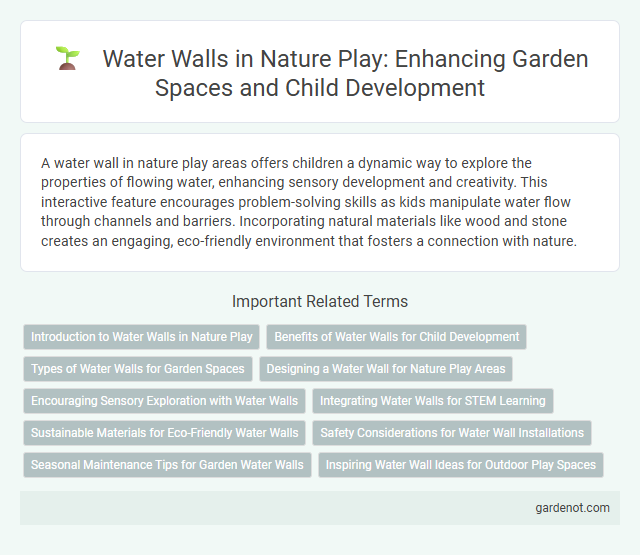A water wall in nature play areas offers children a dynamic way to explore the properties of flowing water, enhancing sensory development and creativity. This interactive feature encourages problem-solving skills as kids manipulate water flow through channels and barriers. Incorporating natural materials like wood and stone creates an engaging, eco-friendly environment that fosters a connection with nature.
Introduction to Water Walls in Nature Play
Water walls in nature play environments create interactive, sensory-rich experiences by encouraging children to explore the properties of water through movement, sound, and touch. Constructed with various materials such as wood, metal, and recycled elements, these vertical structures often feature funnels, gears, and channels that facilitate water flow and experimentation. This hands-on engagement supports cognitive development, fine motor skills, and environmental awareness in young learners.
Benefits of Water Walls for Child Development
Water walls enhance sensory exploration by allowing children to engage with flowing water, promoting tactile and visual stimulation critical for cognitive growth. Manipulating water flow improves fine motor skills and hand-eye coordination while encouraging problem-solving and cause-and-effect understanding. Exposure to natural water elements also supports emotional regulation and creativity, fostering a calming and imaginative play environment.
Types of Water Walls for Garden Spaces
Water walls for garden spaces come in various types, including cascading, sheet flow, and bubbling designs, each offering unique sensory and aesthetic benefits. Cascading water walls feature tiered levels for dynamic water movement, while sheet flow walls create a smooth, continuous water surface that enhances tranquility. Bubbling water walls incorporate air bubbles into the flow, adding sound and texture that enrich nature play environments.
Designing a Water Wall for Nature Play Areas
Designing a water wall for nature play areas involves incorporating sustainably sourced materials such as natural stone, reclaimed wood, and non-toxic sealants to ensure environmental safety. The structure should feature adjustable flow controls and varied water channels to promote sensory exploration and fine motor skills development among children. Effective drainage and water recycling systems optimize resource use while minimizing ecological impact in outdoor play environments.
Encouraging Sensory Exploration with Water Walls
Water walls provide a dynamic sensory experience by engaging sight, sound, and touch, which promotes cognitive development and fine motor skills in children. The flowing water stimulates curiosity and encourages experimentation with cause-and-effect, enhancing problem-solving abilities. Integrating water walls into nature play settings supports sensory exploration and fosters emotional regulation through interactive, hands-on learning.
Integrating Water Walls for STEM Learning
Integrating water walls into STEM learning environments enhances hands-on experimentation with fluid dynamics, physics, and engineering principles. These interactive structures promote critical thinking and problem-solving as children manipulate water flow and observe cause-effect relationships. Incorporating water walls fosters engagement in scientific exploration while encouraging collaborative play and creativity.
Sustainable Materials for Eco-Friendly Water Walls
Water walls made from sustainable materials such as reclaimed wood, bamboo, and recycled metal reduce environmental impact while creating an eco-friendly play environment. These materials ensure durability and safety, promoting natural water flow and sensory exploration without harmful chemicals or plastics. Incorporating rainwater collection systems enhances water conservation, making water walls an integral part of sustainable nature play areas.
Safety Considerations for Water Wall Installations
Water wall installations in nature play areas require non-toxic, durable materials and securely anchored structures to prevent tipping hazards. Proper drainage systems and smooth edges minimize the risk of slips, falls, and cuts, ensuring safe interaction for children. Regular maintenance checks for leaks and water quality uphold sanitary conditions, reducing exposure to harmful bacteria or mold.
Seasonal Maintenance Tips for Garden Water Walls
Seasonal maintenance for garden water walls includes cleaning debris and algae buildup to ensure optimal water flow and prevent clogs. Inspect pumps and filtration systems regularly, replacing worn parts before colder months to avoid damage from freezing temperatures. Applying weather-resistant sealants protects wooden or stone structures from seasonal wear and prolongs the water wall's durability.
Inspiring Water Wall Ideas for Outdoor Play Spaces
Inspiring water wall ideas for outdoor play spaces include incorporating recycled materials such as plastic bottles and PVC pipes to create engaging, eco-friendly structures that promote hands-on exploration. Designing multi-level walls with varied spouts, channels, and funnels encourages children to experiment with water flow, enhancing sensory and motor skills. Integrating natural elements like stones and plants around the water wall enriches the play experience by fostering curiosity and environmental awareness.
Water wall Infographic

 gardenot.com
gardenot.com